Sultan Bathery | |
|---|---|
Municipality | |
 | |
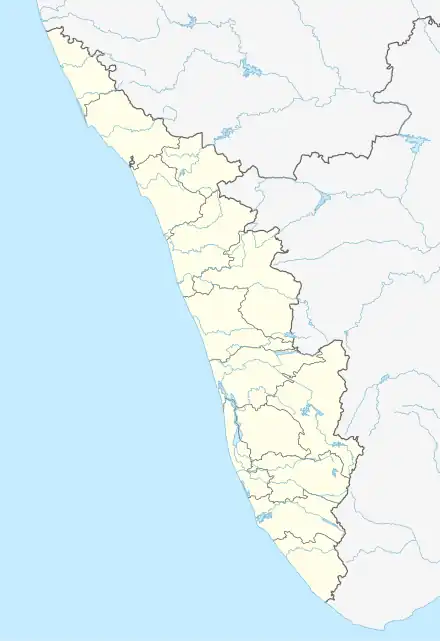 Sultan Bathery Location in Kerala, India  Sultan Bathery Sultan Bathery (India) | |
| Coordinates: 11°40′N 76°17′E / 11.67°N 76.28°E | |
| Country | |
| State | Kerala |
| District | Wayanad |
| Named for | artillery battery of Tipu Sultan |
| Government | |
| • Municipal Chairperson | T. K. Ramesh |
| Area | |
| • Total | 102.24 km2 (39.48 sq mi) |
| Elevation | 901 m (2,956 ft) |
| Population (2011) | |
| • Total | 45,417 |
| • Density | 440/km2 (1,200/sq mi) |
| Languages | |
| • Official | Malayalam, English |
| Time zone | UTC+5:30 (IST) |
| PIN | 673592 |
| Area code | 91 4936 |
| ISO 3166 code | IN-KL |
| Vehicle registration | KL-73 |
| Sex ratio | 1,029 male/female |
| Literacy | 89.36% |
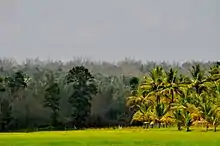


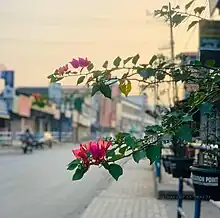
Sultan Bathery is a town and municipality in the Wayanad district of Kerala, India, near its borders with Tamil Nadu and Karnataka. Once known as a strategic location in the Malabar region, Sultan Bathery is now the largest town in Wayanad, and is the headquarters of the Sultan Bathery taluk.[1]
It is credited with being Kerala's cleanest town and is known for its tourism and commercial activities. The prehistoric caves, jungle trails, streams and rivers and lush greenery of the undulating hills draw a lot of tourists to the region every year.
Etymology
The town was part of Kidanganad village, so-called because of the presence of the Kidangans tribes.[2] During the invasion of Malabar by Mysore ruler Tipu Sultan, the town was used by the Mysore army as the storeroom or battery for its ammunition and used the Jain Temple located here as a battery.[3] Thus the town known as "Sultan's Battery" in British records later got to be called as "Sultan Bathery".
Location
Sultan Bathery lies on the Kozhikode–Kollegal National Highway (NH 766) 97 kilometers from Kozhikode. It is 114 km from Mysore[4] and about 100 km from Ooty (Udagamandalam). It is also connected with Nilambur. The town is about 930 metres above mean sea level.
History
The recorded history of Sultan Bathery, commensurate with that of Wayanad, begins in the 10th century. In 930 AD, Emperor Erayappa of the Ganga dynasty led his troops to what would later become the district in the south-west of Mysore and, after conquering it, called it Bayalnad, meaning the land of swamps. After Erayappa died, his sons Rachamalla and Battunga fought each other for the new kingdom of their father's legacy. Rachamalla was killed and Battunga became the undisputed ruler of Bayalnad.
In the 12th century AD, the Gangas were dethroned by the Kadamba dynasty of North Canara.[5] In 1104 AD, Vishnuvardhana of Hoysala invaded Bayalnad followed by the Vijayanagara dynasty in the 16th century. In 1610 AD, Udaiyar Raja Wadiyar of Mysore drove out Vijayanagara and became the ruler of Bayalnad and the Nilgiris. When Wayanad was under Hyder Ali's rule, the ghat road from Vythiri to Thamarassery was constructed.[6] Later, the British rulers developed this route into Carter Road.[7]
British rule began after the East India Company seized Wayanad from the hands of Pazhassi Raja and administered the district until it was superseded by the British Raj in 1858. Until 1947, Wayanad was under the rule of the Malabar collector. History has it that Wayanad has a rich folk culture that gave way to the British domination of Wayanad. The British named the village Sultan's Battery, which in later history means the Sultan's Armory.
The Edakkal Caves have evidence of the existence of a Neolithic civilisation in Wayanad. According to H. S. Graeme, the Thalassery Sub-Collector T. H. Balan was the first to start a revenue settlement in Wayanad. For administrative convenience, the area was divided into Munnadu, Muthoornadu, Ilangkornadu, Nallurnadu, Edanashankur, Poronnur, Kurumbala, Wayanad, Nambikkoli and Ganapathivattam (Ganapati). The importance and relevance of Ganapati has been mentioned often in the reports. History records that Sultan Bathery later became the place of Ganapati on the roadside during the battle of Hyder Ali and Tipu Sultan.
Ganapati (Ganapathivattam) is believed to have been a commercial centre during this period and a place on the road to Mysore. Ganapati grew as the medieval cities flourished, the four-way street, the main highway, and the center of worship. In 1934, the Kidanganad Panchayat was established. From the administration of the Malabar District Board, Ganapati became the administrative centre of the Kidanganad panchayat. The Niluppuzha Panchayat was formed in 1968 by the division of Kidanganad Panchayat, Nenmeni Panchayat in 1974 and Sultanbathery Panchayat in 1968.
New places of worship and educational institutions have emerged in different parts of the panchayat with the support of Hindu, Muslim and Christian communities. The Ganapati Temple, the Jain Temple and the Malankara Mosque are examples of the ancient history of Sultan Bathery. There is evidence that Sultan Bathery and other parts of Wayanad had been in contact through Tamil, Karnataka and Kodagu villages since medieval times. Sultan Bathery is known as the confluence of ancient and ancient cultures. The history of Sultan Bathery completes the history of the colonists and bureaucrats who came to the land for the reward of their plight.
In the late 20th century, the first glimpses of educational activities began to appear. As a result of the efforts of the 1920s, an LP school was established in the Sultan Bathery under the Malabar District Board. From then until now the progress of the country has been enormous.
From time immemorial, the region was home to the native tribes of Chettiars, Paniyar, Kurumar and Urali Nayakkar. Although there are many ethnic groups among the people, their main occupation is agriculture. The panchayath has 26 temples, 15 churches and 15 mosques. Sultan Bathery has a Jain temple that is about 2,000 years old. The center, which is in the possession of the Department of Archeology, has no festivals other than temple rituals. The festival at Sultan Bathery Mariamman Kovil is one of the festivals celebrated here. It is considered to be the national festival of Bathery. Similar festivals are celebrated in the Bathery Mahaganapathi Temple, Kuppadi Devi Temple and Karivallikkunnu Temple.[8]
Tourism



- Edakkal caves are located 10 km from Sultan Bathery and are noted for anthropological research. The caves are two natural rock formations believed to have been formed by a large split in a huge rock.
- Jain Temple is one of the prominent Jain temples in Kerala, the Bathery Jain Temple is believed to have been built in the 13th century. This Mahavir stone temple at Kidanganad in Sultan Bathery is also known as Digambara Jain Temple and Kidanganad Basti. The temple architecture, inscriptions and drawings on the pillars and walls are strongly influenced by the architectural style of the Vijayanagara dynasty. An interesting inscription on one of the pillars depicts Dharnendra Bandanam, in the form of a coiled snake.
- Krishnagiri Stadium is a cricket stadium located in Krishnagiri village in Wayanad. It holds up to 20,000 people and at 2,100 feet above sea level is the highest-altitude stadium used exclusively for cricket.[9]
- Thovarimala Ezhuthupara
- Wayanad Heritage Museum, Ambalavayal
- Wayanad Wildlife Sanctuary houses a wide range of mammals, birds and other fauna. The mammals include elephants, tigers, panthers, jungle cats, civet cats, monkeys, wild dogs, bison, deer, and bears. More than 200 species of birds, including peacocks, babblers, cuckoos, owls, woodpeckers and jungle fowl, and 45 species of reptiles like monitor lizard and a variety of snakes and tortoises reside there.
Education
There are many government and private schools offering education. Compared to other districts of Kerala, institutions offering higher education are limited in Wayanad.[10] One of the oldest colleges in Wayanad is St Mary's College, Sulthan Bathery, established in 1965.[11] This arts and science college is affiliated with the University of Calicut. Pazhassi Raja College in Pulpally, established in 1982, is another major college located nearby.[12]
Transportation
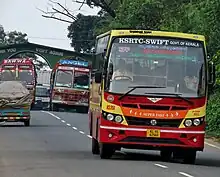
Sultan Bathery has very good road connectivity with south Indian states. The major road is NH 766 which connects to Mysore, Bangalore and Kozhikode, two state highways connected to Ooty and Coimbatore and a state highway connected to Mangalore, Kannur, Thalassery and Kasaragod. Sultan Bathery is the biggest transport hub of Wayanad district. It is located near the border with the Karnataka state.
There is a major Kerala Transport Depot in Sultan Bathery. Most of the long-distance buses to Kozhikode, Ooty and Bangalore start from this depot. The town also has two smaller bus stations for local travellers. The Periya ghat road connects Mananthavady to Kannur and Thalassery. The Thamarassery mountain road connects Calicut with Kalpetta. The Kuttiady mountain road connects Vatakara with Kalpetta and Mananthavady. The Palchuram mountain road connects Kannur and Iritty with Mananthavady. The road from Nilambur to Ooty is also connected to Wayanad through the village of Meppadi.
The nearest railway stations are at Mysore and Calicut. The nearest airports are at Mysore, Calicut and Kannur.
Geography
Sultan Bathery is located at 11°40′N 76°17′E / 11.67°N 76.28°E.[13] It has an average elevation of 907 m (2,976 ft).
Politics
The Sultan Bathery assembly constituency is part of the Wayanad Lok Sabha constituency. Its member of parliament is Rahul Gandhi of the Indian National Congress (INC) party,[14] and the MLA is I. C. Balakrishnan (INC).
The Sultan Bathery Municipality has been governed by the Left Democratic Front (LDF) since 2015.
- Chairperson: TK Ramesh (Communist Party of India (Marxist) (CPI(M))
- Vice Chairperson: Elsy Paulose (CPI(M))
Since its establishment in 1962, the Bathery panchayat (council) has mainly been held by the INC-led United Democratic Front (UDF). P. C. Ahmed Haji of the Indian Union Muslim League was the first president and held office for three decades. The LDF was in power for only eight months in 2005 with the help of the Democratic Indira Congress (Kerala) party. The president was CK Sahadevan who later became the first chairman when it was converted to a municipality in 2015.
Municipality Chairperson
Source:
| No: | Name | Party | Year | Division | |
|---|---|---|---|---|---|
| 1 | C. K. Sahadevan | CPI(M) | 18 November 2015–03/04/2018 | 1st | Beenachi |
| 2 | T. L. Sabu | Kerala Congress (M) | 26 April 2018–11 November 2020 | Kattayad | |
| 3 | T. K. Ramesh | CPI(M) | 28 December 2020–incumbent | 2nd | Dottappankulam |
Members of Legislative Assembly
Source: [15]
| Election | Niyama Sabha | Member | Party | Tenure | |
|---|---|---|---|---|---|
| 1977 | 5th | K. Raghavan Master | INC | 1977–1980 | |
| 1980 | 6th | K. K. Ramachandran Master | 1980–1982 | ||
| 1982 | 7th | 1982–1987 | |||
| 1987 | 8th | 1987–1991 | |||
| 1991 | 9th | K. C. Rosakutty | 1991–1996 | ||
| 1996 | 10th | P. V. Varghese Vaidyar | CPI(M) | 1996–2001 | |
| 2001 | 11th | N. D. Appachan | INC | 2001–2006 | |
| 2006 | 12th | P. Krishna Prasad | CPI(M) | 2006–2011 | |
| 2011 | 13th | I. C. Balakrishnan | INC | 2011–2016 | |
| 2016 | 14th | 2016–2021 | |||
| 2021 | 15th | 2021–2026 | |||
Municipality Vice Chairperson
Source:
| No: | Name | Party | Year | Division | |
|---|---|---|---|---|---|
| 1 | Jisha Shaji | CPI(M) | 18/11/2015–11 November 2020 | 1st | Kuppady |
| 2 | Elsy Paulose | CPI(M) | 28/12/2020–incumbent | 2nd | Sultan Bathery |
Grama Panchayat President
Source:
| No: | Name | Party | Year |
|---|---|---|---|
| 1 | P. C. Ahamad Haji | IUML | |
| 2 | Special Officer | – | 1979–1980 |
| 3 | P. C. Ahamad Haji | IUML | 1980–1985 |
| 4 | Special Officer | – | |
| 5 | P. C. Ahamad Haji | IUML | |
| 6 | P. C. Ahamad Haji | IUML | |
| 7 | N. M. Vijayan | INC | |
| 8 | Nafeeza Ahamad koya | IUML | 2000–2005 |
| 9 | C. K. Sahadevan | CPI(M) | 2005–2006 |
| 10 | Babu Pazhupathoor | INC | 2006-2006 |
| 11 | Radha Raveendran | INC | 2006–2009 |
| 12 | O. M. George | INC | 2009–2010 |
| 13 | P. P. Ayyoob | IUML | 2010–2012 |
| 14 | O. M. George | INC | 2012–2015 |
Municipality
Sultan Bathery Municipality | |
|---|---|
| History | |
| Founded | 2015 |
| Leadership | |
T. K. Ramesh | |
Secretary | K. M. Sainudheen |
| Structure | |
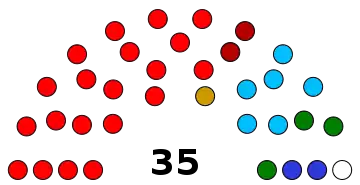 | |
Political groups | LDF (24)
UDF (11)
|
| Website | |
| sulthanbatherymunicipality | |
| Position | Name | Party | Division |
|---|---|---|---|
| Chairperson | T. K. Ramesh | CPI(M) | Dottappankulam |
| Deputy Chairperson | Elsy Paulose | CPI(M) | Sultan Bathery |
| Standing Committee | Chairperson | Party | Division |
|---|---|---|---|
| Finance | Elsy Paulose | CPI(M) | Sultan Bathery |
| Development | Lisha Teacher | CPI(M) | Kidangil |
| Welfare | C. K. Sahadevan | CPI(M) | Manthamkolly |
| Health | Shamila Junaise | Independent (LDF) | Manichira |
| Public Works | K Rasheed | CPI(M) | Kuppady |
| Education, Arts & Sports | Tom Jose | Kerala Congress (M) | Manthandikunnu |
| Division number | Division name | Member | Role | Party | Category |
|---|---|---|---|---|---|
| 1 | Aram mile | Girija Chandran | Councillor | IUML | ST Woman |
| 2 | Chethalayam | A. R. Jayakrishnan | Councillor | CPI(M) | General |
| 3 | Chenad | Nisha P. R. | Councillor | CPI(M) | Woman |
| 4 | Vengur North | Bindhu Ravi | Councillor | CPI(M) | Woman |
| 5 | Odappallam | Priya Vinod | Councillor | CPI(M) | Woman |
| 6 | Vengur South | Sheeba Chacko | Councillor | CPI(M) | Woman |
| 7 | Pazhery | Radakrishnan | Councillor | CPI(M) | ST |
| 8 | Karuvallikunnu | Valsa Jose | Councillor | INC | Woman |
| 9 | Armad | Samshad P | Councillor | Independent (UDF) | General |
| 10 | Kottakunnu | P. K. Sumathi | Councillor | CPI(M) | Woman |
| 11 | Kidangil | Lisha Teacher | Councillor | CPI(M) | Woman |
| 12 | Kuppady | K Rasheed | Councillor | CPI(M) | General |
| 13 | Thirunelly | Saly Paulose | Councillor | CPI(M) | Woman |
| 14 | Manthandikunnu | Tom Jose | Councillor | Kerala Congress (M) | General |
| 15 | Sathramkunnu | Prajitha Ravi | Councillor | INC | Woman |
| 16 | Cheroorkunnu | Radha Raveendran | Councillor | INC | Woman |
| 17 | Palakkara | Pramod K. S. | Councillor | CPI(M) | SC |
| 18 | Thelambatta | Hema C | Councillor | CPI(M) | Woman |
| 19 | Thoduvatty | Asees Madala | Councillor | INC | General |
| 20 | Kaipanchery | Jamsheer Ali | Councillor | CPI(M) | General |
| 21 | Maithanikunnu | Babu M. C. | Councillor | CPI(M) | General |
| 22 | Fairland | Shameer Madathil | Councillor | Independent (LDF) | General |
| 23 | Kattayad | Nisha Sabu | Councillor | Independent | Woman |
| 24 | Sultan Bathery | Elsy Paulose | Deputy Chairperson | CPI(M) | General |
| 25 | Pallikandi | Harif A. C. | Councillor | IUML | General |
| 26 | Manichira | Shamila Junaise | Councillor | Independent (LDF) | Woman |
| 27 | Kalluvayal | Salim Madathil | Councillor | CPI(M) | General |
| 28 | Poomala | Bindhu Saji | Councillor | CPI(M) | Woman |
| 29 | Dottappankulam | T. K. Ramesh | Chairperson | CPI(M) | ST |
| 30 | Beenachi | Bindhu Pramod | Councillor | CPI(M) | Woman |
| 31 | Poothikadu | K. C. Yohannan | Councillor | CPI(M) | General |
| 32 | Cheenapullu | Radha Babu | Councillor | IUML | ST Woman |
| 33 | Manthamkolly | C. K. Sahadevan | Councillor | CPI(M) | General |
| 34 | Pazhupathur | Mercy Teacher | Councillor | INC | Woman |
| 35 | Kaivattamoola | Shoukath Kallikudan | Councillor | Independent (UDF) | General |
Places of worship
- Sultan Bathery Jain Temple – A Jain temple believed to have been built in the 13th century. It is one of the main Jain shrines in Kerala.
- Sultan Bathery Juma Masjid: This is the largest congregational mosque (juma masjid) in the town and can hold more than 1000 worshippers. The masjid is situated near the Sultan Bathery bus stop.
- Ganapati Temple: Sultan Bathery Ganapathi Temple is a famous Lord Ganesh Temple. It built eight centuries ago. Sulthan Bathery was formerly known as Ganapathivattom, signifying the presence of this ancient Lord Ganapathy Temple.
- Masjid Madeena: A juma masjid in town run by Jama at e Islami Hind (JIH)
- Soonoro Church: St. Mary's Jacobite Syrian Orthodox Church, Sulthan's Bathery is a famous pilgrim centre in Wayanad.
- Masjidul Mnar: A juma masjid run by Kerala Nadvathul Mujahideen.
- Shaduli Masjid: The famous juma masjid in the town.
- St. Mary's Orthodox Cathedral, Sultan Bathery: one of the main churches for people who belong to the Malankara Orthodox Syrian Church.
- Assumption Church: one of the major Christian churches located in the heart of the city.
- Mariyamman Temple: This is the most important temple for the local tribes. The yearly festival is in February–March which gathers a lot of crowds.
- CSI St. Thomas Church: This church is situated near police station.
- The Pentecostal Mission (TPM): The Faith Home (church) is situated at College Road, Kottakunnu.
- India Pentecostal Church of God, Thrikkepatta, Sultan Bathery
- Masjid Jami'a Ideal Campus, Snehagiri, Sultan Bathery
- Thalachill Temple, Sultan Bathery
- Narasimha temple, Sultan Bathery
- Church of God in Malabar, located near the Stadium, Manikuni
- Assemblies of God in India Church, Chungam
- St. Thomas Malankara Syrian Catholic Cathedral, Sultan Bathery
- Church of God (Full Gospel) in India city church
Climate
Sultan Bathery has a humid climate. The mean average rainfall in this area is 2,322 mm. Lakkidi, Vythiri and Meppadi are the high rainfall areas in Wayanad. The annual rainfall in these areas ranges from 3,000 to 4,000 mm. High-velocity winds are common during the southwest monsoon season and dry winds blow in March and April. High altitude regions experience severe cold. In Wayanad (Ambalavayal) the mean maximum and minimum temperature for the last five years were 29 °C and 18 °C respectively. This place experiences high relative humidity, which can rise to 95 per cent during the southwest monsoon period. Generally the year is classified into four seasons, namely, the cold weather (December–February), hot weather (March–May), southwest monsoon (June–September), and northeast monsoon (October–November) seasons.
| Climate data for Sultan Bathery, Kerala | |||||||||||||
|---|---|---|---|---|---|---|---|---|---|---|---|---|---|
| Month | Jan | Feb | Mar | Apr | May | Jun | Jul | Aug | Sep | Oct | Nov | Dec | Year |
| Mean daily maximum °C (°F) | 26.3 (79.3) |
28.3 (82.9) |
30.0 (86.0) |
30.1 (86.2) |
29.1 (84.4) |
25.7 (78.3) |
24.2 (75.6) |
24.8 (76.6) |
25.7 (78.3) |
26.1 (79.0) |
25.8 (78.4) |
25.7 (78.3) |
26.8 (80.3) |
| Mean daily minimum °C (°F) | 15.6 (60.1) |
16.8 (62.2) |
18.5 (65.3) |
19.9 (67.8) |
20.1 (68.2) |
19.1 (66.4) |
18.8 (65.8) |
18.7 (65.7) |
18.5 (65.3) |
18.6 (65.5) |
17.6 (63.7) |
16.1 (61.0) |
18.2 (64.8) |
| Average precipitation mm (inches) | 3 (0.1) |
8 (0.3) |
14 (0.6) |
89 (3.5) |
171 (6.7) |
451 (17.8) |
903 (35.6) |
497 (19.6) |
225 (8.9) |
220 (8.7) |
79 (3.1) |
21 (0.8) |
2,681 (105.7) |
| Source: Climate-Data.org[17] | |||||||||||||
Notable residents
- Basil Joseph, director in the Malayalam film industry[18]
See also
References
- ↑ "Maha Ganapathi Temple – Sulthan Bathery – Travel Info".
- ↑ "Archaeological Survey of India". asi.nic.in.
- ↑ Nair, Susheela (28 August 2023). "Sulthan Bathery: The journey from an ammunition depot to Kerala's cleanest town". The News Minute. Retrieved 21 September 2023.
- ↑ "Mysore to Sulthan Bathery". mysore.ind.in. Retrieved 13 January 2013.
- ↑ Moraes, George M. (1931). The Kadamba Kula. Bombay: B. X. Furtado & Sons.
- ↑ Madras District Gazetteers – the Nilgiris by W. Francic, pages 90–104. Madras, 1908.
- ↑ Report of the Administration of Mysore, 1863–64. British Parliament Library.
- ↑ "ചരിത്രം | Sulthanbatherymunicipality.gov.in". sulthanbatherymunicipality.lsgkerala.gov.in.
- ↑ "Krishnagiri Stadium in Wayanad | Districts of Malabar". www.keralatourism.org. Retrieved 7 November 2023.
- ↑ "Short history of Wayanad" (PDF). Retrieved 18 July 2012.
- ↑ "St Mary's College, Sulthan Bathery official website". Retrieved 18 July 2012.
- ↑ "Pazhassi Raja college, Pulpally official website". Archived from the original on 4 October 2012. Retrieved 18 July 2012.
- ↑ "Maps, Weather, and Airports for Sultans Battery, India". www.fallingrain.com.
- ↑ "Assembly Constituencies – Corresponding Districts and Parliamentary Constituencies" (PDF). Kerala. Election Commission of India. Archived from the original (PDF) on 4 March 2009. Retrieved 19 October 2008.
- ↑ "Members of Kerala Legislative Assembly: Sulthan Bathery". Maps of India.
- ↑ "Local Self Government Department | Local Self Government Department". lsgkerala.gov.in.
- ↑ "Sulthan Bathery climate: Average Temperature, weather by month, Sulthan Bathery weather averages - Climate-Data.org". en.climate-data.org.
- ↑ S, Harikumar J. (10 October 2018). "Basil Joseph on his side-splitting act and Thiruvananthapuram dialect in 'Padayottam'". The Hindu. ISSN 0971-751X. Retrieved 6 May 2022.
External links
 Media related to Sultan Bathery at Wikimedia Commons
Media related to Sultan Bathery at Wikimedia Commons Sultan Bathery travel guide from Wikivoyage
Sultan Bathery travel guide from Wikivoyage- Official website of the Wayanad district
